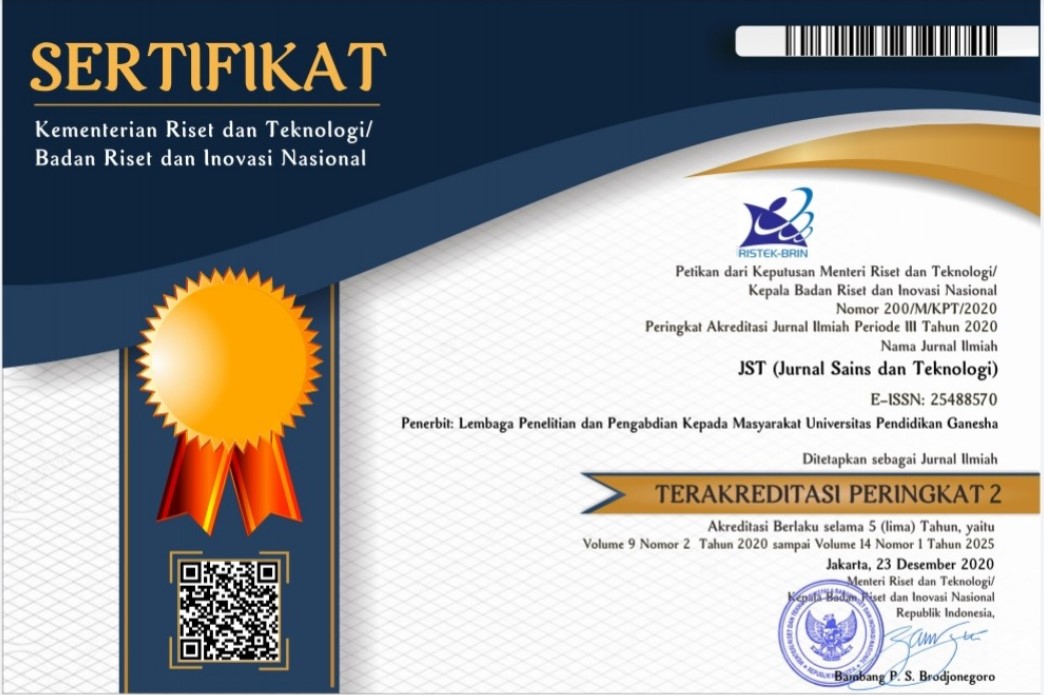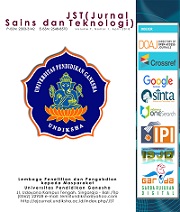Transformasi Gas Rumah Kaca: Mengubah CO2 Menjadi Bahan Bernilai Tinggi Berupa Precipitated Calcium Carbonate (PCC)
DOI:
https://doi.org/10.23887/jstundiksha.v13i2.79553Keywords:
CO2, Air, Kalsit, Vaterit, AragonitAbstract
Gas CO2 dapat mengakibatkan pemanasan global dan pada kadar tertentu mempengaruhi kesehatan manusia. Untuk menjaga kadar CO2 di lingkungan dalam kondisi normal, penelitian ini mencoba mengonversi CO2 menjadi produk berupa precipitated calcium carbonate (PCC). Tujuan penelitian ini adalah menganalisa pengaruh kecepatan pengadukan, tekanan sistem reaksi, dan waktu interaksi pada pembuatan PCC menggunakan reaktor semi-batch. Pengumpulan data melibatkan 4 kali replikasi untuk setiap variabel, sehingga total subjek uji coba sebanyak 32. Penelitian ini dilakukan dengan metode karbonasi yaitu dengan cara mengontakkan gas CO2 dengan Ca(OH)2 untuk menghasilkan PCC, yang mana dilakukan pada tekanan hidrostatis 980-9800 Pa, kecepatan 400 dan 500 rpm, laju alir CO2 2 liter/menit, dan waktu interaksi 15-60 menit. Guna mengetahui jumlah produk yang dihasilkan dilakukan analisis menggunakan analisis gravimetri, sedangkan jenis produk PCC dianalisis menggunakan alat instrumentasi. Hasil penelitian menunjukkan bahwa tekanan sistem reaksi, waktu interaksi, dan kecepatan pengadukan berpengaruh terhadap laju reaksi antara CO2 dan Ca(OH)2 serta produk PCC yang dihasilkan. Kondisi operasi optimum diperoleh pada tekanan 9800 Pa, kecepatan pengadukan 400 rpm, dan waktu interaksi 60 menit dengan massa PCC yang dihasilkan sebesar 7,99 gram, dengan produk PCC yang dihasilkan di dominasi oleh jenis kalsit. Hasil dari penelitian ini diharapkan dapat memberikan kontribusi dalam pengembangan teknologi yang lebih efisien untuk mengonversi CO₂ menjadi produk yang berguna, seperti PCC, yang memiliki aplikasi luas di berbagai sektor industri.
References
Abdullah, S. N., Hamzah, F., Husain, N. C., Veny, H., Rodhi, M. N. M., & Mohidem, N. A. (2023). Effect of Temperature and CO2 Flowrate on the Formation of CaCO3 in the Hydration Reaction of CO2 Catalyzed by Immobilized Carbonic anhydrase into PVDF Membrane. Chemical Engineering Transactions, 106(170), 1015–1020. https://doi.org/10.3303/CET23106170.
Arias, B., Criado, A., Y., P., B., & Abanades, J. C. (2022). Carbonation kinetics of Ca (OH) 2 under conditions of entrained reactors to capture CO2. Industrial & Engineering Chemistry Research, 61(9), 3272–3277. https://doi.org/10.1021/acs.iecr.1c04888. DOI: https://doi.org/10.1021/acs.iecr.1c04888
Cai, J., Zhao, Q., Hsu, W. Y., Choi, C., Liu, Y., Martirez, J. M. P., & Huang, Y. (2023). Highly selective electrochemical reduction of CO2 into methane on nanotwinned Cu. Journal of the American Chemical Society, 145(16), 9136–9143. https://doi.org/10.1021/jacs.3c00847. DOI: https://doi.org/10.1021/jacs.3c00847
Chen, Z., Wang, W., Forzieri, G., & Cescatti, A. (2024). Transition from positive to negative indirect CO2 effects on the vegetation carbon uptake. Nature Communications, 15(1). https://doi.org/10.1038/s41467-024-45957-x. DOI: https://doi.org/10.1038/s41467-024-45957-x
Cihanoglu, G., Karabiyik, M., Odabasi, I., & Balkose, D. (2022). Composition, Morphology, Optical, Thermal and Mechanical Properties of Yogurt Containers. European Journal of Technique, 12(2), 145–151. https://doi.org//10.36222/ejt.1054357. DOI: https://doi.org/10.36222/ejt.1054357
Conejo, A. N. (2020). Physical and mathematical modelling of mass transfer in ladles due to bottom gas stirring: A review. Processes, 8(7), 750. https://doi.org/10.3390/pr8070750. DOI: https://doi.org/10.3390/pr8070750
Dasmen, R. N., & Akbar, R. (2023). Air Quality Monitoring System And Air Neutralizer In Hotel Rooms With Notification Via Telegram. Tech-E, 6(2), 17–24. https://jurnal.buddhidharma.ac.id/index.php/te/article/view/1842.
Dhakshinamoorthy, A., Navalón, S., Primo, A., & García, H. (2024). Selective Gas‐Phase Hydrogenation of CO2 to Methanol Catalysed by Metal‐Organic Frameworks. Angewandte Chemie, 136(3), 202311241. https://doi.org/10.1002/ange.202311241. DOI: https://doi.org/10.1002/ange.202311241
Ghosh, A., Nag, D., Chatterjee, R., Singha, A., Dash, P. S., Choudhury, B., & Bhaumik, A. (2024). CO 2 to dimethyl ether (DME): structural and functional insights of hybrid catalysts. Catalysis Science & Technology. DOI: https://doi.org/10.1039/D3CY01497E
Hogan, J. A., Domke, G. M., Zhu, K., Johnson, D. J., & Lichstein, J. W. (2024). Climate change determines the sign of productivity trends in US forests. Proceedings of the National Academy of Sciences, 121(4), 2311132121. https://doi.org/10.1073/pnas.2311132121. DOI: https://doi.org/10.1073/pnas.2311132121
Hou, G., Wang, Q., Xu, D., Fan, H., Liu, K., Li, Y., & Ding, M. (2024). Dimethyl Carbonate Synthesis from CO2 over CeO2 with Electron‐enriched Lattice Oxygen Specises. Angewandte Chemie International Edition, e202402053. https://doi.org/10.1002/anie.202402053. DOI: https://doi.org/10.1002/ange.202402053
Hu, H., Chen, J., Zhou, F., Nie, M., Hou, D., Liu, H., & Liang, Y. (2024). Relative increases in CH4 and CO2 emissions from wetlands under global warming dependent on soil carbon substrates. Nature Geoscience, 1–6(17), 1. https://www.nature.com/articles/s41561-023-01345-6. DOI: https://doi.org/10.1038/s41561-023-01345-6
Junaedy, S., Dan, Z. A., & Idaryani. (2022). Rancang Bangun Alat Kontroling Kadar Udara Bersih Dan Gas Berbahaya Co, Co2 Dalam Ruangan Berbasis Mikrokontroler. Jurnal Teknologi Dan Komputer (JTEK, 2(02), 216–222. https://doi.org/10.56923/jtek.v2i02.104. DOI: https://doi.org/10.56923/jtek.v2i02.104
Khan, S., Das, P., Thaher, M., Abdulquadir, M., Faisal, M., Hawari, A. H., & Al-Jabri, H. (2024). Application note—A novel, low-cost pH-controlled solenoid-based CO2 dosing device for microalgal and cyanobacterial cultivation systems. Smart Agricultural Technology, 7, 100373. https://doi.org/10.1016/j.atech.2023.100373. DOI: https://doi.org/10.1016/j.atech.2023.100373
Khine, E. E., Koncz-Horvath, D., Kristaly, F., Ferenczi, T., Karacs, G., Baumli, P., & Kaptay, G. (2022). Synthesis and characterization of calcium oxide nanoparticles for CO2 capture. Journal of Nanoparticle Research, 24(7), 139. https://doi.org/10.1007/s11051-022-05518-z. DOI: https://doi.org/10.1007/s11051-022-05518-z
Kim, S., Lee, S. G., & Jeong, D. H. (2024). Direct Synthesis of Dimethyl Carbonate from CO2: From the Perspective of Dimethyl-Carbonate, A Promising Material for the Future. Chemical Engineering Research and Design. https://doi.org/10.1016/j.cherd.2024.02.010. DOI: https://doi.org/10.1016/j.cherd.2024.02.010
Koch, C. J., Suhail, Z., Goeppert, A., & Prakash, G. S. (2023). CO2 capture and direct air CO2 capture followed by integrated conversion to methane assisted by metal hydroxides and a Ru/Al2O3 catalyst. ChemCatChem, 15(23), 202300877. https://doi.org/10.1002/cctc.202300877. DOI: https://doi.org/10.1002/cctc.202300877
Küçükhüseyin, Ö. (2021). CO2 monitoring and indoor air quality. REHVA Eur. HVAC J, 58, 54–59.
Kuliyev, S., Tas, Y. E., & Selim Cogenli, M. (2023). Contol of CO2 Absorption by NaOH Solution Using pH, Conductivity, and Titration Measurement. Chemical Problems/Kimya Problemləri, 21(2). https://doi.org/10.32737/2221-8688-2023-2-123-131.
Lee, Y. G., Lee, H. U., Lee, J. M., Kim, N. Y., & Jeong, D. H. (2024). Design of Dimethyl Carbonate (DMC) Synthesis Process Using CO2, Techno-economic Analysis, and Life Cycle Assessment. Korean Journal of Chemical Engineering, 41(1), 1–17. https://orcid.org/0000-0002-4005-3153. DOI: https://doi.org/10.1007/s11814-024-00019-2
Legout, P., Lefebvre, G., Bonnin, M., Gimel, J. C., Benyahia, L., Gibaud, A., & Calvignac, B. (2022). Reactive precipitation of vaterite calcium carbonate microspheres in supercritical carbon dioxide-water dispersion by microfluidics. The Journal of Supercritical Fluids, 188, 105678. https://doi.org/10.1016/j.supflu.2022.105678. DOI: https://doi.org/10.1016/j.supflu.2022.105678
Leong, Y. K., & Chang, J. S. (2023). Waste stream valorization-based low-carbon bioeconomy utilizing algae as a biorefinery platform. Renewable and Sustainable Energy Reviews, 178, 113245. https://doi.org/10.1016/j.rser.2023.113245. DOI: https://doi.org/10.1016/j.rser.2023.113245
Ling, L. L., Guan, X., Liu, X., Lei, X. M., Lin, Z., & Jiang, H. L. (2024). Promoted hydrogenation of CO2 to methanol over single-atom Cu sites with Na+ decorated microenvironment. National Science Review, 11(6). https://doi.org/10.1093/nsr/nwae114. DOI: https://doi.org/10.1093/nsr/nwae114
Liotta, L. F., & Wu, H. (2024). CO2 Capture, Utilization and Storage: Catalysts Design. Catalysts, 14(1), 80. https://doi.org/10.3390/catal14010080. DOI: https://doi.org/10.3390/catal14010080
Livescu, A., Navar, R., Mangalindan, J. R., Mahnaz, F., Ge, Y., Shetty, M., & Yang, X. (2024). Catalysts for Clean Energy: A Review on Current Progress for the Catalyzed Recycling of CO2 into Dimethyl Ether. In Topics in Catalysis (pp. 1–22). https://doi.org/10.1007/s11244-024-01913-z. DOI: https://doi.org/10.1007/s11244-024-01913-z
Luo, X., Song, X., Cao, Y., & Bu, X. (2020). Investigation of calcium carbonate synthesized by steamed ammonia liquid waste without use of additives. The Royal Society of Chemistry, 10(13), 7976–7986. https://doi.org/10.1039/C9RA10460G. DOI: https://doi.org/10.1039/C9RA10460G
Ma, S., Huang, Y., Zhu, X., Xia, A., Zhu, X., & Liao, Q. (2024). Growth-based dynamic light transmission modeling and optimization in microalgal photobioreactors for high efficiency CO2 fixation. Renewable and Sustainable Energy Reviews, 197, 114414. https://doi.org/10.1016/j.rser.2024.114414. DOI: https://doi.org/10.1016/j.rser.2024.114414
Ma, Y., Zhang, X., Du, Z., Hou, H., & Zheng, Y. (2024). Research on Utilizable Calcium from Calcium Carbide Slag with Different Extractors and Its Effect on CO2 Mineralization. Materials, 17(5), 1068. https://doi.org/10.3390/ma17051068. DOI: https://doi.org/10.3390/ma17051068
Madhania, S., Ihsana, Y., Rizaldy, M. Z., Afdiwibowo, A., Kusdianto, K., & Winardi, S. (2020). Preparation of precipitated calcium carbonate from carbon mineralization of raw biogas with Ca (OH) 2 solution using bubble column contactor. AIP Conference Proceedings, 2219(1). https://doi.org/10.1063/5.0003060. DOI: https://doi.org/10.1063/5.0003060
Munawaroh, F., Ahied, M., & Muharrami, L. K. (2019). The effect of Ca (OH) 2 slurry concentration on precipitated CaCO3 product. AIP Conference Proceedings, 2202(1). https://doi.org/10.1016/j.fuel.2022.125259. DOI: https://doi.org/10.1063/1.5141630
Noor, S., Rehman, A., Iqbal, S., Iqbal, M., & Rehman, E. W. U. (2024). Novel Applications Of Precipitated Calcium Carbonate In Food, Pharmaceutical, And Cosmetic Industry. AND COSMETIC INDUSTRY. Journal of Population Therapeutics and Clinical Pharmacology, 31(1), 529–543. https://doi.org/10.53555/jptcp.v31i1.4039. DOI: https://doi.org/10.53555/jptcp.v31i1.4039
Nunes, L. J. (2023). The rising threat of atmospheric CO2: a review on the causes, impacts, and mitigation strategies. Environments, 10(4), 66. https://doi.org/10.3390/environments10040066. DOI: https://doi.org/10.3390/environments10040066
Nuryoto, N., Mas’ulunniah, N., Choerunnisa, A. S., & Suripno, S. (2021). Pemanfaatan Karbon Dioksida Untuk Sintesis Precipitated Calcium Carbonate (Pcc) Dengan Metode Karbonasi. Jurnal Integrasi Proses, 10(2), 90–95. https://doi.org/10.36055/jip.v10i2.12286. DOI: https://doi.org/10.36055/jip.v10i2.12286
Okeke-Ogbuafor, N., Gray, T., Kamara, S., Sesay, E., Dauda, A., Stead, S. M., & Ani, K. J. (2024). Climate-smart fisheries: CO2 emissions reduction and food security are complementary. Marine Policy, 159, 105926. https://doi.org/10.1016/j.marpol.2023.105926. DOI: https://doi.org/10.1016/j.marpol.2023.105926
Park, J., Choi, W. Y., Jang, K., Lee, S., Kim, E., Moulay, I., & Lee, D. (2024). Experimental And Integrated Computational Study On CCUS Technology Utilizing Desalinated Brine. https://doi.org/10.21203/rs.3.rs-3690519/v1. DOI: https://doi.org/10.21203/rs.3.rs-3690519/v1
Pusparizkita, Y. M., Schmahl, W. W., Ambarita, M., Kholid, H. N., Sadewa, A. Y., Ismail, R., & Bayuseno, A. P. (2023). Mineralizing CO2 and producing polymorphic calcium carbonates from bitumen-rock asphalt manufacturing solid residues. Cleaner Engineering and Technology, 12, 100602. https://doi.org/10.1016/j.clet.2023.100602. DOI: https://doi.org/10.1016/j.clet.2023.100602
Rezvi, H. U. A., Tahjib‐Ul‐Arif, M., Azim, M. A., Tumpa, T. A., Tipu, M. M. H., Najnine, F., & Brestič, M. (2023). Rice and food security: Climate change implications and the future prospects for nutritional security. Food and Energy Security, 12(1), 430. https://doi.org/10.1002/fes3.430. DOI: https://doi.org/10.1002/fes3.430
Rivera, R. M., & Gerven, T. (2020). Production of calcium carbonate with different morphology by simultaneous CO2 capture and mineralisation. Journal of CO2 Utilization, 41, 101241. https://doi.org/10.1016/j.jcou.2020.101241. DOI: https://doi.org/10.1016/j.jcou.2020.101241
Rizzetto, A., Piumetti, M., Pirone, R., Sartoretti, E., & Bensaid, S. (2024). Study of ceria-composite materials for high-temperature CO2 capture and their ruthenium functionalization for methane production. Catalysis Today, 429, 114478. https://doi.org/10.1016/j.cattod.2023.114478. DOI: https://doi.org/10.1016/j.cattod.2023.114478
Rodriguez-Navarro, C., Ilić, T., Ruiz-Agudo, E., & Elert, K. (2023). Carbonation mechanisms and kinetics of lime-based binders: An overview. Cement and Concrete Research, 173, 107301. https://doi.org/10.1016/j.cemconres.2023.107301. DOI: https://doi.org/10.1016/j.cemconres.2023.107301
Rojas-Buzo, S., Salusso, D., Jouve, A., Bracciotti, E., Signorile, M., & Bordiga, S. (2024). CO2 to dimethylcarbonate synthesis: Surface defects and oxygen vacancies engineering on MOF-derived CexZr1− xO2− y catalysts. Applied Catalysis B: Environment and Energy, 346(1), 123723. https://doi.org/10.1016/j.apcatb.2024.123723. DOI: https://doi.org/10.1016/j.apcatb.2024.123723
Rosseira, A. A., Hafizah, A. N., Fadzil, M. A., Faliq, M. B., Irfan, N. K., & Rohaya, O. (2023). Early CO2 capturing mortar by incorporating a new potential carbide lime waste under controlled CO2 curing. Journal of Physics: Conference Series, 2521(1), 12007. https://doi.org/1088/1742-6596/2521/1/012007. DOI: https://doi.org/10.1088/1742-6596/2521/1/012007
Sadig, K., Emre, T. Y., & Selim, C. M. (2023). Control Of Co2 Absorption By Naoh Solution Using Ph, Conductivity And Titration Measurements. Kimya Problemleri, 21(2), 123–131. https://cyberleninka.ru/article/n/control-of-co2-absorption-by-naoh-solution-using-ph-conductivity-and-titration-measurements. DOI: https://doi.org/10.32737/2221-8688-2023-2-123-131
Salleh, E. M., Othman, R., Mahim, Z., & Sabri, S. N. (2021). Effect of liquid feeding rate on carbonation of precipitated calcium carbonate via continuous method. Journal of Physics, 2080(1), 12017. https://doi.org/10.1088/1742-6596/2080/1/012017. DOI: https://doi.org/10.1088/1742-6596/2080/1/012017
Sari, E., Desmiarti, R., Arief, S., Rosadi, M. Y., Naldi, N., Hutagaol, H. A., & Kurniawan, E. (2023). Synthesis of precipitated calcium carbonate with the addition of aloe vera extract under different reaction temperatures. International Journal of Applied Science and Engineering, 20(1), 1–7. https://doi.org/10.6703/IJASE.202303_20(1).007. DOI: https://doi.org/10.6703/IJASE.202303_20(1).007
Slingo, J. M., & Slingo, M. E. (2024). The science of climate change and the effect of anaesthetic gas emissions. Anaesthesia, 79(3), 252–260. https://doi.org/10.1111/anae.16189. DOI: https://doi.org/10.1111/anae.16189
Sun, C., Xia, Y., Ye, X., Xu, W., Shi, H., Gao, X., & Li, J. (2024). Optimizing CO2 Hydrogenation to DME through Tailored Interfacial Interactions: Weakening Synergy in CuZnZr and Al-Modified SBA-15 Catalysts. Industrial & Engineering Chemistry Research. https://doi.org/10.1021/acs.iecr.3c03606. DOI: https://doi.org/10.1021/acs.iecr.3c03606
Valluri, S., Claremboux, V., & Kawatra, S. (2022). Opportunities and challenges in CO2 utilization. Journal of Environmental Sciences, 113, 322–344. https://doi.org/10.1016/j.jes.2021.05.043. DOI: https://doi.org/10.1016/j.jes.2021.05.043
Walerowski, M., Potter, M., Burke, E., Kyrimis, S., Armstrong, L. M., & Raja, R. (2024). Designing Bifunctional Catalysts for the One-pot Conversion of CO2 to Sustainable Marine Transportation Fuels. Catalysis Science & Technology. https://doi.org/10.1039/D4CY00020J. DOI: https://doi.org/10.1039/D4CY00020J
Wulandari, V., & Yohandri. (2023). Design and Construction of Air Quality Monitoring System using NodeMCU IoT-Based. Journal of Experimental and Applied Physics, 1(2). https://doi.org/10.24036/jeap.v1i2.23.
Zevenhoven, R., Legendre, D., Said, A., & Järvinen, M. (2019). Carbon dioxide dissolution and ammonia losses in bubble columns for precipitated calcium carbonate (PCC) production. Energy, 175, 1121–1129. https://doi.org/10.1016/j.energy.2019.03.112. DOI: https://doi.org/10.1016/j.energy.2019.03.112
Zimmerli, N. K., Rochlitz, L., Checchia, S., Müller, C. R., Copéret, C., & Abdala, P. M. (2024). Structure and role of a Ga-promoter in Ni-based catalysts for the selective hydrogenation of CO2 to Methanol. JACS Au, 4(1), 237–252. https://doi.org/10.1021/jacsau.3c00677. DOI: https://doi.org/10.1021/jacsau.3c00677
Downloads
Published
How to Cite
Issue
Section
License
Copyright (c) 2024 Nuryoto Nuryoto, Heri Heriyanto, Leli Rahmawati, Herliza Julvita

This work is licensed under a Creative Commons Attribution-ShareAlike 4.0 International License.
Authors who publish with the Jurnal Sains dan Teknologi (JST) agree to the following terms:
- Authors retain copyright and grant the journal the right of first publication with the work simultaneously licensed under a Creative Commons Attribution License (CC BY-SA 4.0) that allows others to share the work with an acknowledgment of the work's authorship and initial publication in this journal.
- Authors are able to enter into separate, additional contractual arrangements for the non-exclusive distribution of the journal's published version of the work (e.g., post it to an institutional repository or publish it in a book), with an acknowledgment of its initial publication in this journal.
- Authors are permitted and encouraged to post their work online (e.g., in institutional repositories or on their website) prior to and during the submission process, as it can lead to productive exchanges, as well as earlier and greater citation of published work. (See The Effect of Open Access)















